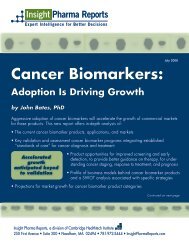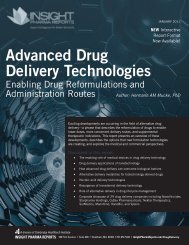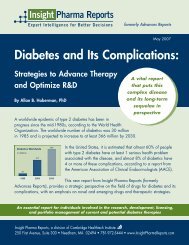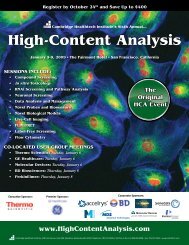2010 Best Practices Competition IT & Informatics HPC
IT Informatics - Cambridge Healthtech Institute
IT Informatics - Cambridge Healthtech Institute
- No tags were found...
Create successful ePaper yourself
Turn your PDF publications into a flip-book with our unique Google optimized e-Paper software.
CAC network connectivity includes the national NSF TeraGrid and New York State<br />
Grid.<br />
The DataDirect Networks S2A9700 storage system is used as the central storage<br />
platform for a number of departments and applications. Initially deployed for<br />
backup and archival storage, CAC is increasingly using the S2A9700 as front‐line<br />
storage for applications such as genome sequencing.<br />
Since CAC provides services to a wide range of Cornell departments and<br />
applications, implementing centralized storage platforms is critical in ensuring<br />
an efficient, reliable and cost‐effective infrastructure.<br />
Cornell researchers were considering buying commodity, off‐the‐shelf storage<br />
solutions to locally store their research data. While the cost of such technology<br />
appeared initially low – the lack of coordination, data protection and system<br />
reliability detracted from the long‐term value of this approach. As research<br />
productivity and access to data are directly correlated – the primary focus of<br />
the storage solution had to be high reliability and scalability.<br />
It was clear that an affordable, centrally managed, highly available research<br />
storage system was needed in order to control costs and also to ensure that<br />
researchers remained productive. Accommodating a variety of applications and<br />
departments would prove a challenge for ordinary storage systems, but the DDN<br />
S2A9700 proved capable even beyond the initial scope of the project.<br />
Results: The center selected an S2A9700 storage system from DDN with<br />
40TB unformatted capacity in RAID‐ 6 configurations. DDN partnered with Ocarina<br />
Networks to provide transparent, content‐aware storage optimization at CAC,<br />
reducing the overall capacity need by more than 50 percent. For some Microsoft<br />
SQL database applications, a compression rate of up to 82 percent was achieved.<br />
DDN storage technology enables massive scalability and capacity optimization<br />
through storage collaboration. As compared to other storage technologies in it's<br />
class ‐ the S2A9700 features industry leading throughput (at over 2.5GB/s per<br />
system), capacity (scalable to hold up to<br />
2.4 Petabytes in a single system) and data center efficiency (DDN systems are the<br />
densest in the industry, housing up to 600 hard drives in a single data center<br />
rack ‐ also featuring Dynamic MAID power management technology). The combination<br />
of the S2A9700 system scale and the data center optimized configuration proved to<br />
Cornell that installing and adding capacity could be done very cost‐effectively<br />
and the system could scale to meet the Center's evolving storage volume<br />
requirements without a forklift upgrade.<br />
"We have been very impressed with the performance DDN's S2A9700 delivers,"<br />
said David A. Lifka, CAC director. "For genomics research ‐ Cornell uses Solexa<br />
Sequencers and the DDN storage system is directly connected to the compute<br />
cluster, while at the same time continuing to provide backup and archive storage<br />
for our other projects and departments."<br />
‐ David A. Lifka, CAC Director<br />
Ocarina’s ECOsystem platform uses an innovative approach to data reduction. The<br />
ECOsystem first extracts files into raw binary data and applies object boundaries








